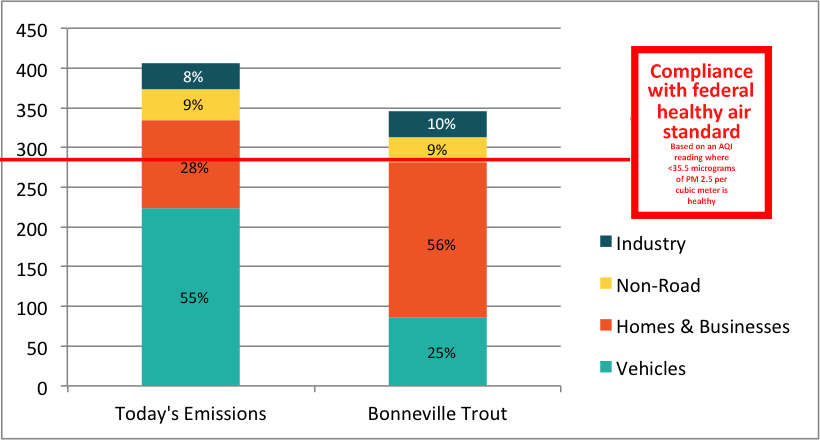The Story
We take little personal or collective action to achieve cleaner air.
New 2014 state and federal regulations initially reduce car and other emissions, improving air quality. By 2050, however, these improvements are largely offset by the near doubling of homes, businesses, and cars. Driving per person does not decrease, although 90% of Utah’s cars are low-emission because of the phase-in of 2014 federal requirements. Included within the 90% cleaner cars are 5% of Utah’s cars that are electric or zero-emission, having been voluntarily purchased by Utahns. Some refineries avoid producing cleaner fuels.
Pollution is not reduced from old or new homes and businesses; the energy efficiency of buildings is not improved through higher building standards.
Summary of Actions Taken
| Vehicles | Homes and Businesses | Industries |
|---|---|---|
|
|
|
Results
- Emissions reduce by 20%.
- We do not meet health standards in 2050.
- Homes and businesses replace vehicles as the primary producers of pollution.
- Average household saves $100 per year.
- Some businesses , employees, and tourists hesitate to come to Utah.
Change in Emissions from today

Source: Utah Division of Air Quality (includes emissions from Utah, Salt Lake, Davis, Weber, Cache, Tooele, and Box Elder Counties)
Background
For most of the year, Utah’s air is clean and meets federal health standards, but for some periods in the summer, and particularly in the winter, regional weather patterns cause poor air conditions along the Wasatch Front. Poor winter air quality is a result of particulate matter (PM) that forms in the air from chemical reactions as well as by directly emitted particulates. Today, these emissions mainly come from mobile sources (cars, trucks, etc.), though they are also produced by area sources (space heating, water heating, wood burning, etc.), point sources (industry), and non-road sources (engine-powered devices that operate off roadways, such as construction equipment, airplanes, snow blowers, etc.).
Poor summer air quality is a result of ozone pollution which is produced by many of the same sources as PM.
New federal regulations will result in the gradual phase-in of cleaner cars over decades. These cars, when combined with cleaner fuels, will reduce automobile emissions by 80%. The cleaner cars have smog ratings of 8 or higher, as shown on the window sticker or at fueleconomy.gov. A car with a smog rating of 10 has no tailpipe emissions (e.g., an electric car). These new regulations also require the production of cleaner (lower-sulfur) fuels, but some Utah refineries could take advantage of exemptions and not produce the cleaner fuel.
New 2014 state regulations (the State Implementation Plan) require significantly reduced emissions from a variety of sources, including industry.
Though cars will get cleaner, the number of Utah homes and businesses will nearly double by 2050. These area sources will become the dominant source of air pollutants, growing until they dwarf vehicle emissions. Improving the energy efficiency and lowering the emissions of both old and new buildings (either voluntarily or through new air quality, energy, or construction standards) is crucial if Utah is to meet health standards over the long term.


